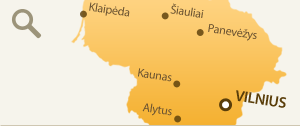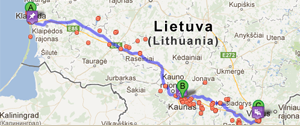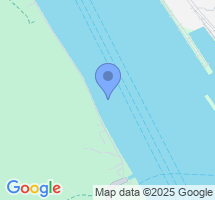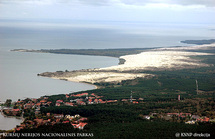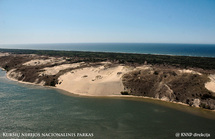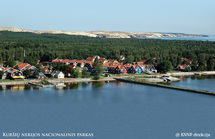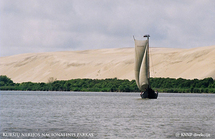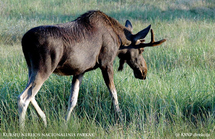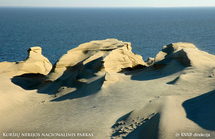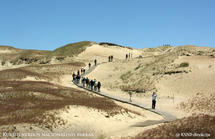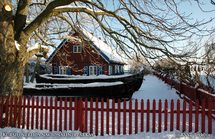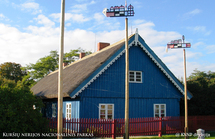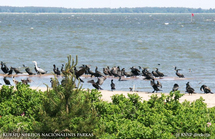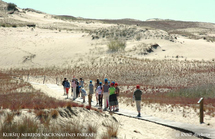Kursiu nerija National Park, (Curonian Spit), Lithuania
Kursiu nerija (Curonian Spit) is a narrow and long (97 km) band of sand, which stretches along the Baltic Sea, in the western part of Lithuania. The Curonian Lagoon washes its eastern shores while the Baltic Sea washes the western ones. A part of the Curonian Spit (overall 50 km) belongs to the Republic of Lithuania; the other part belongs to Russian Federation. In order to preserve the most valuable landscape complexes, Kursiu nerija National Park was established there in 1991. Curonian Spit is unique of its still drifting sand dunes, the sea side forests cherishing the hundred-years-old pine trees, dunes covered by hand-planted mountain pines’ carpet, white sand beaches and the old fishermen villages.
According to the legend, long time ago Curonian Spit was formed by a giant girl called Neringa, which poured sandy peninsula in the Baltic Sea to separate the peaceful bay from stormy sea and create an embankment for fishermen to live.
In 2000 – the World Heritage Committee has inscribed the Curonian Spit on the World Heritage List as the cultural landscape. Human habitation of this elongated sand dune peninsula dates back to prehistoric times. Throughout this period it has been threatened by the natural forces of wind and waves. Its survival to the present days has been made possible only as a result of ceaseless human efforts to combat the erosion of the Spit, dramatically illustrated by continuing stabilization and reforestation projects.
The area of the park is 26464 ha. 9764 ha are covered by land, and 16700 ha - by water.
The Curonian Spit is part of “Natura 2000”, the network of protected territories in Europe, connecting the most valuable habitations and territories. It is also belongs to HELCOM, the system of protecting territories in the Baltic Sea.
The dunes are an exclusive element of the Curonian Spit landscape. In Curonian Spit you can find and explore all stages of formation of the dunes: embryonic shifting dunes, humid dune slacks, decalcified fixed dunes, wooded dunes, white and grey dunes, which are famous for theirs unique beauty. 11 types of European importance protected habitats occur in Curonian Spit. Different habitats have rare species of insects, birds, and plants specific and typical for the place. Some of them are endangered and included in the Red Book of Lithuania.
The birds migration way from the Baltic Sea to the White Sea runs through the Curonian Spit. Every year millions of birds fly by there. It is unique place for bird watchers. Curonian Spit is important for large concentrations of migrating passerines and birds of prey. The Curonian Spit Lagoon and the Baltic Sea along the coastline are the important for migratory and wintering water birds. Also Curonian Spit is famous for the largest breeding colony of Great Cormorants in Lithuania.
There are 37 species of mammals living in Curonian Spit. Here you can meet fox and hare, boar and beavers, roe deer and even elk, others species of mammals.
Curonian Spit retains the following items of cultural heritage: fishing settlement, valuable of its ethno cultural, historical and aesthetic point of view, architectural works, which are unique in scale and archeological sites, mostly villages, buried under the sand.
The settlements of the Curonian spit until the 19th century were typical fishermen villages – monuments of special significance of kursiai community way of living and ethnographic traditions, which are not upheld anymore. The earliest fishing settlements were buried in sand, when the wood cover was removed. Those that have survived since the beginning of the 19th century are all to be found along the coast of the Curonian Lagoon. There one can observe the specific structure of fishermen homestead, traditional wooden dwellings, colored in dark brown and dark blue colors, decorated with specific wooden carvings, which concentrate in the gable.
Of special significance are the traditional grave markers known as krikstai. These are timber planks decorated with flowers, hearts, birds’ silhouettes, and even animal motifs.
Kursiu nerija National Park is an outstanding place which lets explore and get to know nature, culture and traditions in an active and environment friendly way. Curonian Spit is a perfect place for observing of wildlife, sustainable tourism, leisure and cultural self expression. Here you enjoy cycling, hiking and canoe tours or sailings trips, try traditional fisherman’s food. There are many places, which are visited of many people each year: Sea Museum and Dolphinarium, Kursiu nerija National Park Landscape Exposition, Historical Museum of Neringa, Galleries of Amber and Weathervanes, Thom Mann Memorial Museum, Ethnographic Farmstead of Fisherman. The Hill of Witches and cognitive path “Nature Puzzle” are favourite among children.
People of all nations and ages are welcome here!
Visitors centre in Smiltyne
Smiltynes str. 11, LT-93100 Klaipėda. Tel./fax.: +370 46 402256 E-mail: info@nerija.lt
Visitors centre in Nida
Nagliu str.8, LT-93123 , Neringa. Tel./fax.: +370 469 51256 E-mail: infonida@nerija.lt
Website: http://www.nerija.lt
Nearby objects
 Nuomojame nuo balandžio15d. iki spalio 15d, kaina asmeniui 30-40 Lt. (~5.6 km)
Nuomojame nuo balandžio15d. iki spalio 15d, kaina asmeniui 30-40 Lt. (~5.6 km) Horsemarket jojimo paslaugų centras – puiki vieta mėgstantiems žirgus, gamtą ir geras emocijas. (~12.4 km)
Horsemarket jojimo paslaugų centras – puiki vieta mėgstantiems žirgus, gamtą ir geras emocijas. (~12.4 km) Vieno kambario apartamentų nuoma Palangoje vos už 50 Lt. parai (~23.5 km)
Vieno kambario apartamentų nuoma Palangoje vos už 50 Lt. parai (~23.5 km) Viešbutis, restoranas, mini SPA, vyno rūsys, konferencijų salė. (~127.9 km)
Viešbutis, restoranas, mini SPA, vyno rūsys, konferencijų salė. (~127.9 km) Šiaurės Lietuvoje, 28 km nuo Šiaulių, 5 km nuo Radviliškio, 49 km nuo Panevėžio, pakeliui į Tytuvėnus ir Raseinius, miškų apsuptyje, kur… (~153.2 km)
Šiaurės Lietuvoje, 28 km nuo Šiaulių, 5 km nuo Radviliškio, 49 km nuo Panevėžio, pakeliui į Tytuvėnus ir Raseinius, miškų apsuptyje, kur… (~153.2 km) Niekada negali žinoti ar tau patiks, kol pats neišbandai naujos pramogos. (~196.7 km)
Niekada negali žinoti ar tau patiks, kol pats neišbandai naujos pramogos. (~196.7 km) Viešbutis „Metropolis“, garsėjantis įspūdinga istorija, yra vienas iš labiausiai žinomų viešbučių Lietuvoje (~199.2 km)
Viešbutis „Metropolis“, garsėjantis įspūdinga istorija, yra vienas iš labiausiai žinomų viešbučių Lietuvoje (~199.2 km) Viešbutis – Restoranas „Sfinksas“ įsikūręs ramiame, netoli miesto centro esančiame kampelyje. Ramybė, aukštas aptarnavimo lygis, jaukumas –… (~200.1 km)
Viešbutis – Restoranas „Sfinksas“ įsikūręs ramiame, netoli miesto centro esančiame kampelyje. Ramybė, aukštas aptarnavimo lygis, jaukumas –… (~200.1 km) Conviva -nedidelis, jaukus 3 žvaigždučių viešbutis pačiame Panevėžio miesto centre. (~203.9 km)
Conviva -nedidelis, jaukus 3 žvaigždučių viešbutis pačiame Panevėžio miesto centre. (~203.9 km) Nauji, jaukūs butai Druskininkų senamiesty, prie Vijūnėlės ežero. (~262.5 km)
Nauji, jaukūs butai Druskininkų senamiesty, prie Vijūnėlės ežero. (~262.5 km) Druskininkų „Medinukas“ - ko gero pati jaukiausia vieta praleisti atostogas ar savaitgalį populiariausiame kurorte Lietuvoje. (~262.6 km)
Druskininkų „Medinukas“ - ko gero pati jaukiausia vieta praleisti atostogas ar savaitgalį populiariausiame kurorte Lietuvoje. (~262.6 km) Apartamentų Ratnyčėlė Druskininkuose nuoma. (~263.7 km)
Apartamentų Ratnyčėlė Druskininkuose nuoma. (~263.7 km) Kaimo turizmo sodyba „Gervių takas“ įsikūrusi 45 kilometrai nuo Vilniaus centro vaizdingose Trakų rajono Strėvos apylinkėse esančiame… (~263.9 km)
Kaimo turizmo sodyba „Gervių takas“ įsikūrusi 45 kilometrai nuo Vilniaus centro vaizdingose Trakų rajono Strėvos apylinkėse esančiame… (~263.9 km) Visai prie pat Šiaulių miesto 4 žvaigždučių motelis ir puikiai įrengta užeiga.
Jums siūlome 1 liukso, 4 pusiau liukso, 9 dviviečius… (~280.9 km)
Visai prie pat Šiaulių miesto 4 žvaigždučių motelis ir puikiai įrengta užeiga.
Jums siūlome 1 liukso, 4 pusiau liukso, 9 dviviečius… (~280.9 km) Poilsis, stovyklos, vaikų stovyklos, poilsio bazė „Rūta“, kaimo turizmas, apgyvendinimas, furšetai (~280.9 km)
Poilsis, stovyklos, vaikų stovyklos, poilsio bazė „Rūta“, kaimo turizmas, apgyvendinimas, furšetai (~280.9 km)
Vilniaus pedagoginis universitetas (bendrabutis – svečių namai)
VPU bendrabutis – svečių namai įsikūrę visai šalia Vilniaus senamiesčio, vos keletas minučių… (~287.5 km) Kavinė
Pas mus kvepia kava. Kviečiame stabtelėt, atsipūsti minutėlei ir pasimėgauti kvapnios puikios kavos puodeliu, tokios kaip Jūs… (~289.1 km)
Kavinė
Pas mus kvepia kava. Kviečiame stabtelėt, atsipūsti minutėlei ir pasimėgauti kvapnios puikios kavos puodeliu, tokios kaip Jūs… (~289.1 km) Drūtūnai – aktyvus poilsis gamtoje. Ignalinos rajone, nuostabios gamtos, ežerų bei upių apsuptyje įsikūrusi didelė, puikiai išpuoselėta… (~314.5 km)
Drūtūnai – aktyvus poilsis gamtoje. Ignalinos rajone, nuostabios gamtos, ežerų bei upių apsuptyje įsikūrusi didelė, puikiai išpuoselėta… (~314.5 km)
Nearby attractions
 Black Sea bottlenose dolphins and California Sea Lions perform during the shows at the Dolphinarium.(~0.8 km)
Black Sea bottlenose dolphins and California Sea Lions perform during the shows at the Dolphinarium.(~0.8 km) A sculpture design - little boy with a dog waving with his hat, emerged on the terminal in summer 2007. (~0.9 km)
A sculpture design - little boy with a dog waving with his hat, emerged on the terminal in summer 2007. (~0.9 km) In front of the former City Hall, in the small square near Danė River, stands the sculpture „Fisherman".(~1.3 km)
In front of the former City Hall, in the small square near Danė River, stands the sculpture „Fisherman".(~1.3 km) The main feature of the Theater Square is the sculpture called "Taravos Anikė" (Ann from Tharau).(~1.3 km)
The main feature of the Theater Square is the sculpture called "Taravos Anikė" (Ann from Tharau).(~1.3 km) Drama theatre started its activity in 1935 when closed Šiauliai theatre troupe moved to the seaport. (~1.3 km)
Drama theatre started its activity in 1935 when closed Šiauliai theatre troupe moved to the seaport. (~1.3 km) It is a historical building in which during the Napoleon wars king of Prussia, Friedrich Wilhelm III with his wife Luise temporary…(~1.3 km)
It is a historical building in which during the Napoleon wars king of Prussia, Friedrich Wilhelm III with his wife Luise temporary…(~1.3 km) Klaipėda Theatre square is the heart of the city. There is a sculpture of Ann from Tharau in the fountain in the middle of the square.(~1.3 km)
Klaipėda Theatre square is the heart of the city. There is a sculpture of Ann from Tharau in the fountain in the middle of the square.(~1.3 km) In front of Jazz club "Kurpiai", in Klaipėda Old Town, a sculpture of a little mouse was build…(~1.3 km)
In front of Jazz club "Kurpiai", in Klaipėda Old Town, a sculpture of a little mouse was build…(~1.3 km) "Old Town Cat" or you can call it "A cat with gentlemans face" started to live in Klaipėda Old Town from 1979. (~1.3 km)
"Old Town Cat" or you can call it "A cat with gentlemans face" started to live in Klaipėda Old Town from 1979. (~1.3 km) Klaipėda is the oldest Lithuania's city: first mentioned in the Chronicles of Memelburg in 1252.(~1.4 km)
Klaipėda is the oldest Lithuania's city: first mentioned in the Chronicles of Memelburg in 1252.(~1.4 km) Algirdas Bosas bronze sculpture "Tower" rose up in Old Town in 1990. In this place there once stood a house which burned down during…(~1.4 km)
Algirdas Bosas bronze sculpture "Tower" rose up in Old Town in 1990. In this place there once stood a house which burned down during…(~1.4 km) The granite monument Arka ("Arch") in the small public garden near the Biržos Bridge was…(~1.4 km)
The granite monument Arka ("Arch") in the small public garden near the Biržos Bridge was…(~1.4 km) Klaipėda old town was decorated with one more decorative element - next to the building in Tiltų Street 1 you can find a basket with…(~1.4 km)
Klaipėda old town was decorated with one more decorative element - next to the building in Tiltų Street 1 you can find a basket with…(~1.4 km) In 2008 summer in Mažvydo alley on one of the buildings in Tiltų Street appeared a sculpture of a small boy, decorating a city emblem…(~1.4 km)
In 2008 summer in Mažvydo alley on one of the buildings in Tiltų Street appeared a sculpture of a small boy, decorating a city emblem…(~1.4 km) At the beginning of 2006, the entrance to Old Town was guarded by mans best friend - the dog. This sculpture of Doberman is named "The…(~1.5 km)
At the beginning of 2006, the entrance to Old Town was guarded by mans best friend - the dog. This sculpture of Doberman is named "The…(~1.5 km) A steel sculpture "Dragon" was created appealing to one of the legends retelling emergence of Klaipėda.(~1.5 km)
A steel sculpture "Dragon" was created appealing to one of the legends retelling emergence of Klaipėda.(~1.5 km) There are two carillons in Lithuania - one in Kaunas and one in Klaipeda. A propos, the set of 16 carillon type bells, cast in the…(~1.5 km)
There are two carillons in Lithuania - one in Kaunas and one in Klaipeda. A propos, the set of 16 carillon type bells, cast in the…(~1.5 km) If you pass by Lietuvininkų Square, you should stop by the monument to Martynas Mažvydas.(~1.5 km)
If you pass by Lietuvininkų Square, you should stop by the monument to Martynas Mažvydas.(~1.5 km) Walking along the river Danė and near the bridge you will see the sailing vessel "Meridianas".(~1.5 km)
Walking along the river Danė and near the bridge you will see the sailing vessel "Meridianas".(~1.5 km) Klaudijus Pūdymas bronze sculpture decorated a crossroad of Tiltų and Turgaus streets.(~1.5 km)
Klaudijus Pūdymas bronze sculpture decorated a crossroad of Tiltų and Turgaus streets.(~1.5 km)

